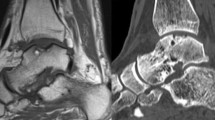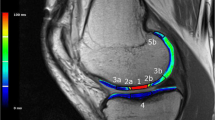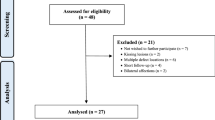Abstract
Purpose
Scientific evidence for the treatment of osteochondral lesions (OCLs) of the talus is limited. The aim of this study was an evaluation of the clinical outcome after a one-step autologous subchondral cancellous bone graft and autologous matrix-induced chondrogenesis (AMIC) in medial OCLs of the talus and the assessment of the repair tissue (RT).
Methods
Seventeen patients (eight women, nine men; mean age, 38.8 ± 15.7 years) with an OCL of the medial talus underwent surgery. Clinical and radiological assessment was performed after a mean follow-up of 39.5 ± 18.4 months, including established scoring systems (American Orthopaedic Foot and Ankle Society [AOFAS] Score, Foot Function Index [FFI], visual analogue scale [VAS]), evaluation of Magnetic Resonance Observation of Cartilage Repair Tissue scoring system (MOCART Score) and T2 mapping.
Results
Preoperative pain (7.8 ± 2.1) significantly improved to an average of 3.2 ± 2.4 postoperatively. AOFAS Score averaged 82.6 ± 13.4, MOCART Score 52.7 ± 15.9. Mean T2 relaxation time of the RT was 41.6 ± 6.3 ms and showed no significant differences to the surrounding cartilage (mean, 38.8 ± 8.5; p = 0.58). MOCART Score significantly correlated with the AOFAS Score (rho = 0.574, p = 0.040). T2 relaxation time of the RT significantly correlated with the MOCART Score (rho = 0.593, p = 0.033).
Conclusions
The one-step autologous subchondral cancellous bone grafting and AMIC leads to a significant reduction in postoperative pain and satisfying postoperative functional outcome in mid-term follow-up. Magnetic resonance imaging (MRI) assessment demonstrated a good quality of regenerative tissue similar to the MRI ultrastructure of the surrounding cartilage.


Similar content being viewed by others
References
Zwingmann J, Sudkamp NP, Schmal H, Niemeyer P (2012) Surgical treatment of osteochondritis dissecans of the talus: a systematic review. Arch Orthop Trauma Surg 132(9):1241–1250. doi:10.1007/s00402-012-1544-1
Giannini S, Buda R, Faldini C, Vannini F, Bevoni R, Grandi G, Grigolo B, Berti L (2005) Surgical treatment of osteochondral lesions of the talus in young active patients. J Bone Joint Surg Am 87(Suppl 2):28–41. doi:10.2106/JBJS.E.00516
Giannini S, Buda R, Cavallo M, Ruffilli A, Cenacchi A, Cavallo C, Vannini F (2010) Cartilage repair evolution in post-traumatic osteochondral lesions of the talus: from open field autologous chondrocyte to bone-marrow-derived cells transplantation. Injury 41(11):1196–1203. doi:10.1016/j.injury.2010.09.028
Schneider TE, Karaikudi S (2009) Matrix-induced autologous chondrocyte implantation (MACI) grafting for osteochondral lesions of the talus. Foot Ankle Int 30(9):810–814. doi:10.3113/FAI.2009.0810
Niemeyer P, Koestler W, Sudkamp NP (2011) Problems and complications of surgical techniques for treatment of full-thickness cartilage defects. Z Orthop Unfall 149(1):45–51. doi:10.1055/s-0030-1250104
LaPrade RF, Botker JC (2004) Donor-site morbidity after osteochondral autograft transfer procedures. Arthroscopy 20(7):e69–73. doi:10.1016/j.arthro.2004.06.022
Salzmann GM, Paul J, Bauer JS, Woertler K, Sauerschnig M, Landwehr S, Imhoff AB, Schottle PB (2009) T2 assessment and clinical outcome following autologous matrix-assisted chondrocyte and osteochondral autograft transplantation. Osteoarthritis Cartilage 17(12):1576–1582. doi:10.1016/j.joca.2009.07.010
Tins BJ, McCall IW, Takahashi T, Cassar-Pullicino V, Roberts S, Ashton B, Richardson J (2005) Autologous chondrocyte implantation in knee joint: MR imaging and histologic features at 1-year follow-up. Radiology 234(2):501–508. doi:10.1148/radiol.2342031970
Nieminen MT, Rieppo J, Toyras J, Hakumaki JM, Silvennoinen J, Hyttinen MM, Helminen HJ, Jurvelin JS (2001) T2 relaxation reveals spatial collagen architecture in articular cartilage: a comparative quantitative MRI and polarized light microscopic study. Magn Reson Med 46(3):487–493
Naal FD, Impellizzeri FM, Huber M, Rippstein PF (2008) Cross-cultural adaptation and validation of the foot function index for use in German-speaking patients with foot complaints. Foot Ankle Int 29(12):1222–1228. doi:10.3113/FAI.2008.1222
Marlovits S, Striessnig G, Resinger CT, Aldrian SM, Vecsei V, Imhof H, Trattnig S (2004) Definition of pertinent parameters for the evaluation of articular cartilage repair tissue with high-resolution magnetic resonance imaging. Eur J Radiol 52(3):310–319. doi:10.1016/j.ejrad.2004.03.014
Salzmann GM, Erdle B, Porichis S, Uhl M, Ghanem N, Schmal H, Kubosch D, Sudkamp NP, Niemeyer P (2014) Long-term T2 and qualitative MRI morphology after first-generation knee autologous chondrocyte implantation: cartilage ultrastructure is not correlated to clinical or qualitative MRI outcome. Am J Sports Med. doi:10.1177/0363546514536682
Valderrabano V, Miska M, Leumann A, Wiewiorski M (2013) Reconstruction of osteochondral lesions of the talus with autologous spongiosa grafts and autologous matrix-induced chondrogenesis. Am J Sports Med 41(3):519–527. doi:10.1177/0363546513476671
Wiewiorski M, Leumann A, Buettner O, Pagenstert G, Horisberger M, Valderrabano V (2011) Autologous matrix-induced chondrogenesis aided reconstruction of a large focal osteochondral lesion of the talus. Arch Orthop Trauma Surg 131(3):293–296. doi:10.1007/s00402-010-1048-9
Wiewiorski M, Miska M, Nicolas G, Valderrabano V (2012) Revision of failed osteochondral autologous transplantation procedure for chronic talus osteochondral lesion with iliac crest graft and autologous matrix-induced chondrogenesis: a case report. Foot Ankle Spec 5(2):115–120. doi:10.1177/1938640011434046
Baum T, Joseph GB, Karampinos DC, Jungmann PM, Link TM, Bauer JS (2013) Cartilage and meniscal T2 relaxation time as non-invasive biomarker for knee osteoarthritis and cartilage repair procedures. Osteoarthritis Cartilage 21(10):1474–1484. doi:10.1016/j.joca.2013.07.012
Palmer AJ, Brown CP, McNally EG, Price AJ, Tracey I, Jezzard P, Carr AJ, Glyn-Jones S (2013) Non-invasive imaging of cartilage in early osteoarthritis. Bone Joint J 95-B(6):738–746. doi:10.1302/0301-620X.95B6.31414
Blackman AJ, Smith MV, Flanigan DC, Matava MJ, Wright RW, Brophy RH (2013) Correlation between magnetic resonance imaging and clinical outcomes after cartilage repair surgery in the knee: a systematic review and meta-analysis. Am J Sports Med 41(6):1426–1434. doi:10.1177/0363546513485931
Jungmann PM, Baum T, Bauer JS, Karampinos DC, Erdle B, Link TM, Li X, Trattnig S, Rummeny EJ, Woertler K, Welsch GH (2014) Cartilage repair surgery: outcome evaluation by using noninvasive cartilage biomarkers based on quantitative MRI techniques? Biomed Res Int 2014:840170. doi:10.1155/2014/840170
Quirbach S, Trattnig S, Marlovits S, Zimmermann V, Domayer S, Dorotka R, Mamisch TC, Bohndorf K, Welsch GH (2009) Initial results of in vivo high-resolution morphological and biochemical cartilage imaging of patients after matrix-associated autologous chondrocyte transplantation (MACT) of the ankle. Skeletal Radiol 38(8):751–760. doi:10.1007/s00256-009-0682-1
Buda R, Vannini F, Castagnini F, Cavallo M, Ruffilli A, Ramponi L, Pagliazzi G, Giannini S (2015) Regenerative treatment in osteochondral lesions of the talus: autologous chondrocyte implantation versus one-step bone marrow derived cells transplantation. Int Orthop. doi:10.1007/s00264-015-2685-y
Battaglia M, Rimondi E, Monti C, Guaraldi F, Sant’Andrea A, Buda R, Cavallo M, Giannini S, Vannini F (2011) Validity of T2 mapping in characterization of the regeneration tissue by bone marrow derived cell transplantation in osteochondral lesions of the ankle. Eur J Radiol 80(2):e132–e139. doi:10.1016/j.ejrad.2010.08.008
de Windt TS, Welsch GH, Brittberg M, Vonk LA, Marlovits S, Trattnig S, Saris DB (2013) Is magnetic resonance imaging reliable in predicting clinical outcome after articular cartilage repair of the knee? a systematic review and meta-analysis. Am J Sports Med 41(7):1695–1702. doi:10.1177/0363546512473258
Giannini S, Buda R, Battaglia M, Cavallo M, Ruffilli A, Ramponi L, Pagliazzi G, Vannini F (2013) One-step repair in talar osteochondral lesions: 4-year clinical results and t2-mapping capability in outcome prediction. Am J Sports Med 41(3):511–518. doi:10.1177/0363546512467622
Albrecht C, Tichy B, Zak L, Aldrian S, Nurnberger S, Marlovits S (2014) Influence of cell differentiation and IL-1beta expression on clinical outcomes after matrix-associated chondrocyte transplantation. Am J Sports Med 42(1):59–69. doi:10.1177/0363546513507543
Conflict of interest
The authors declare that they have no conflict of interest.
Author information
Authors and Affiliations
Corresponding author
Rights and permissions
About this article
Cite this article
Kubosch, E.J., Erdle, B., Izadpanah, K. et al. Clinical outcome and T2 assessment following autologous matrix-induced chondrogenesis in osteochondral lesions of the talus. International Orthopaedics (SICOT) 40, 65–71 (2016). https://doi.org/10.1007/s00264-015-2988-z
Received:
Accepted:
Published:
Issue Date:
DOI: https://doi.org/10.1007/s00264-015-2988-z




